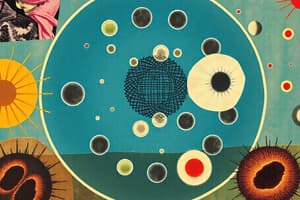Podcast
Questions and Answers
What is the primary structure of DNA?
What is the primary structure of DNA?
- Linear strand of amino acids
- Single strand of nucleotides
- Double helix formed by nucleotides (correct)
- Circular chromosome
Which concept explains how species adapt and change over time?
Which concept explains how species adapt and change over time?
- Theory of Evolution (correct)
- Genetic Drift
- Artificial Selection
- Symbiosis
What term describes the living components of an ecosystem?
What term describes the living components of an ecosystem?
- Energy Flow
- Biotic Factors (correct)
- Trophic Levels
- Abiotic Factors
What process helps maintain stable internal conditions in an organism?
What process helps maintain stable internal conditions in an organism?
Which technology is known for precise modification of DNA?
Which technology is known for precise modification of DNA?
What distinguishes prokaryotic cells from eukaryotic cells?
What distinguishes prokaryotic cells from eukaryotic cells?
Which organelle is responsible for ATP production?
Which organelle is responsible for ATP production?
What is the primary function of ribosomes in a cell?
What is the primary function of ribosomes in a cell?
Which type of biomolecule is primarily responsible for long-term energy storage?
Which type of biomolecule is primarily responsible for long-term energy storage?
What process occurs in the chloroplasts of plant cells?
What process occurs in the chloroplasts of plant cells?
How many ATP molecules are produced through aerobic respiration from one glucose molecule?
How many ATP molecules are produced through aerobic respiration from one glucose molecule?
What is the main consequence of the Law of Segregation in Mendelian genetics?
What is the main consequence of the Law of Segregation in Mendelian genetics?
What is the primary function of nucleic acids?
What is the primary function of nucleic acids?
Flashcards are hidden until you start studying
Study Notes
Cell Structure and Function
- Cell Theory: All living organisms are composed of cells; cells are the basic unit of life; all cells arise from pre-existing cells.
- Types of Cells:
- Prokaryotic: Lack nucleus, smaller size (e.g., bacteria).
- Eukaryotic: Have nucleus, larger size (e.g., plant and animal cells).
- Cell Organelles:
- Nucleus: Contains genetic material (DNA).
- Mitochondria: Powerhouse of the cell, site of ATP production.
- Ribosomes: Protein synthesis.
- Endoplasmic Reticulum (ER): Rough ER (with ribosomes) synthesizes proteins; Smooth ER synthesizes lipids.
- Golgi Apparatus: Modifies and packages proteins for secretion.
- Lysosomes: Contain digestive enzymes for waste processing.
Biomolecules
-
Carbohydrates:
- Function: Energy source and structural support.
- Types: Monosaccharides (glucose), Disaccharides (sucrose), Polysaccharides (starch, cellulose).
-
Proteins:
- Function: Catalysts (enzymes), structural components, transport molecules.
- Structure: Made of amino acids; primary, secondary, tertiary, and quaternary structures.
-
Lipids:
- Function: Long-term energy storage, insulation, make up cell membranes.
- Types: Fats, oils, phospholipids, steroids.
-
Nucleic Acids:
- Function: Genetic information storage and transfer.
- Types: DNA (deoxyribonucleic acid), RNA (ribonucleic acid).
Photosynthesis
- Location: Chloroplasts in plant cells.
- Process: Conversion of light energy into chemical energy.
- Stages:
- Light-dependent reactions: Convert sunlight into ATP and NADPH.
- Light-independent reactions (Calvin Cycle): Use ATP and NADPH to convert CO2 into glucose.
Cellular Respiration
-
Purpose: Energy production from organic compounds.
-
Types:
- Aerobic: Requires oxygen; produces more ATP (36-38 ATP molecules per glucose).
- Anaerobic: Does not require oxygen; less efficient (2 ATP molecules per glucose).
-
Processes:
- Glycolysis: Occurs in the cytoplasm, splits glucose into pyruvate.
- Krebs Cycle: Occurs in mitochondria; generates electron carriers.
- Electron Transport Chain: Produces ATP using oxygen.
Genetics
-
Mendelian Genetics:
- Laws of Segregation: Alleles segregate during gamete formation.
- Laws of Independent Assortment: Genes for different traits are inherited independently.
-
Punnett Squares: Used to predict the probability of offspring genotypes from parental genotypes.
-
DNA Structure: Double helix formed by nucleotides (A, T, C, G) bound by hydrogen bonds.
Evolution and Natural Selection
-
Theory of Evolution:
- Developed by Charles Darwin; species change over time through natural selection.
-
Natural Selection:
- Process where organisms better adapted to their environment tend to survive and produce more offspring.
Ecology
- Ecosystems: Interactions between living organisms and their environment.
- Biotic Factors: Living components (plants, animals, microorganisms).
- Abiotic Factors: Non-living components (climate, soil, water).
- Energy Flow: Energetic relationships in food webs; producers, consumers, and decomposers.
Human Physiology
- Organ Systems:
- Circulatory, respiratory, digestive, nervous, and endocrine systems.
- Homeostasis: Maintenance of stable internal conditions despite external changes.
- Feedback Mechanisms: Regulate physiological processes (e.g., feedback loops in thermoregulation).
Biotechnology
- Genetic Engineering: Manipulation of an organism's DNA to achieve desired traits.
- Cloning: Creating a genetically identical copy of an organism.
- CRISPR-Cas9: A revolutionary gene-editing technology used for precise modification of DNA.
Studying That Suits You
Use AI to generate personalized quizzes and flashcards to suit your learning preferences.




